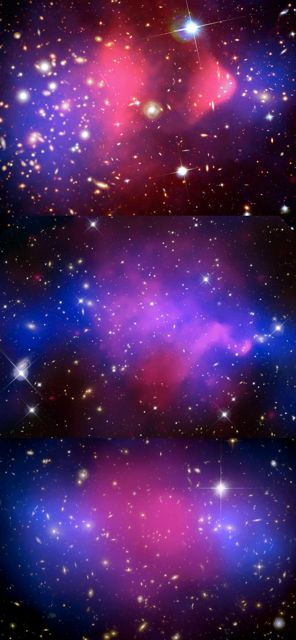Dark matter particle colliders

Galaxy clusters grow by colliding and merging with each other. In Durham we are using these titanic events as enormous particle colliders to investigate the fundamental properties of dark matter. A cluster merger may involve some 1069 particles, with a total energy 1063 times that of each collision at the LHC. During such collisions, the different trajectories followed by clusters' three ingredients (galaxies, gas and dark matter) reveal their particle natures.
Understanding the identity of dark matter remains one of the main unsolved problems in physics. Many lines of evidence now agree that most matter in the Universe consists of non-baryonic elementary particles. Cold Dark Matter models have proved hugely successful on cosmological scales but incorrectly predict individual halos with centrally cusped mass profiles and large amounts of substructure. To reconcile theory with observations, dark matter particles could be either warm or mildly self-interacting supersymmetric partners, axions, or something else.
We are using a joint simulation and observational approach to the assembly and eventual integration of substructures into the main cluster halo. Key tests include the longevity and spatial offset of dark matter substructure during mergers, and the shapes of dark matter haloes once the dust has settled. We are exploiting new observational data from the Hubble Space Telescope and Chandra X-ray observatory, including gravitational lensing measurements from clusters in the MACS, HST Frontier Field and specifically targeted samples. To reliably interpret these observations, we are developing hydrodynamical simulations that incorporate non-standard dark sector physics.
The image shows three major cluster mergers caught while their dark matter (blue) and stars have become spatially offset from their baryonic gas (red) [credits: NASA/CXC/STScI/Clowe/Markevitch/Mahdavi/Bradac]. Minor mergers, involving one massive and one smaller cluster, are less visually striking but just as useful. For example, the "drive-by shooting" of Abell 3827 by five galaxy groups at once, shows the first tentative evidence for interacting dark matter having slowed. We have been awarded time on the Hubble Space Telescope to investigate.
Staff involved with this project at Durham include Celine Boehm, Alastair Edge, Vince Eke, Baojiu Li, Richard Massey and Ian Smail.
Contact Details
Centre for Extragalactic Astronomy,Ogden Centre for Fundament Physics - West,
Department of Physics,
Durham University,
South Road,
Durham DH1 3LE
Tel: 44 (0)191 3343635





